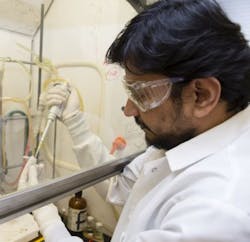New fluorescence imaging reagent targets degenerative diseases
Researchers at South Dakota State University (Brookings, SD) developed a fluorescence imaging reagent that will enable better understanding of degenerative diseases (such as Alzheimer's and Parkinson's) and perhaps lead to ways to treat or prevent them.
Aging and oxidative stress are the culprits of degenerative diseases, but the challenge is to determine which cells, and even subcellular structures, are affected, according to pharmacy professor Xiangming Guan, who led the research.
Organic molecules called thiols play a major role in defending the body against oxidative stress, Guan explains. These antioxidants, which are present inside and outside of cells, counteract the effect of reactive oxygen molecules known as free radicals, which are involved in oxidative stress. Free radicals can disrupt normal cell functions.
Through National Institutes of Health (NIH) grants for nearly $800,000, Guan and his team developed the first imaging reagent that can determine thiol levels in intact living cells. Previous methods of determining thiol concentrations required the destruction of cells and tissue.
"We found a compound which can determine thiol density in live cells in a quantitative way through a particular type of chemical reaction," Guan says. In the presence of thiol, the chemical gives off fluorescence—the higher the thiol level, the higher the fluorescence. Decreased fluorescence means thiols have been consumed trying to protect the cell, meaning it is more likely to be damaged.
With a new three-year NIH grant for $327,500, Guan hopes to develop reagents that can selectively show thiol density in subcellular structures, specifically the nucleus and mitochondria.
Medical researchers now use a centrifuge to separate subcellular structures because their weights are different. Thiol concentration in the mitochondria can be determined via this centrifugal method, but not thiol distribution and density within the mitochondria, Guan explains. In addition, "thiol levels in the nucleus cannot be accurately determined since thiols leak out during isolation."
If researchers see a marked decrease in mitochondrial thiol before onset of Alzheimer's symptoms, Guan explains, "perhaps we can find a way to deliver thiol into the mitochondria to prevent or slow that down."
Furthermore, scientists can use this analytical tool to determine if an intervention protected the subcellular structure, Guan notes. He hopes to develop a nontoxic reagent safe enough to be used for diagnostic imaging, like magnetic resonance imaging (MRI).
-----
Follow us on Twitter, 'like' us on Facebook, connect with us on Google+, and join our group on LinkedIn


